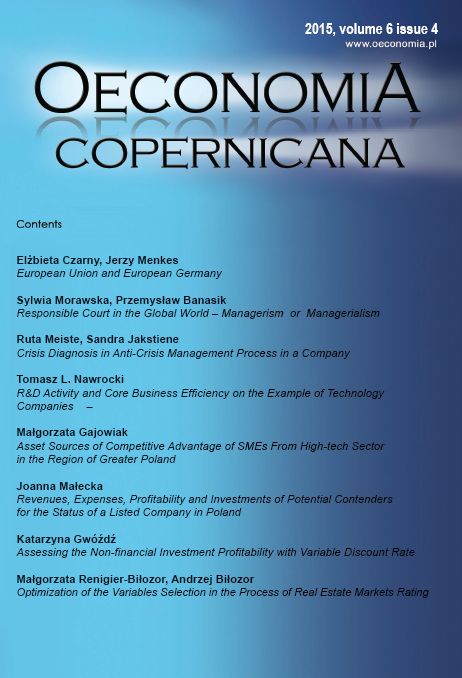Crisis diagnosis in anti-crisis management process in a company
DOI:
https://doi.org/10.12775/OeC.2015.028Keywords:
crisis, diagnosis, anti-crisis management processAbstract
The relevance of the crisis situation diagnosis is confirmed by the diagnosis decisions designed and applied in the business practice, audit reports, bank assessment methods and company?s own concernment. The aim of the research is to define crisis development stages and possible preventive means and to design the crisis diagnosis system in the anti-crisis management process in a company. The paper deals with four stages of crisis development: prodromal crisis (CP), acute crisis (CA), and chronic crisis (CC). Crisis resolution (CR) is the final goal of any crisis management. When a crisis is overcome, its performance stabilizes and a company starts to grow. Therefore, the main point in company?s management process is to notice the barrier when company?s performance starts going down, in order to foresee the result which can cause crisis situation in a company.
Downloads
References
Bivainis, J., & Tamosiunas, A. (2003). Imoniu restrukturizavimo programu valdymas. Verslas: teorija ir praktika, 4(3).
Burksaitiene, D., & Mazintiene, A. (2011). The Role of Bankruptcy Forecasting in the Company Management. Economics and Management. 16
Darling, J. R. & Kash, T. (1998). Crisis Management: Prevention, Diagnosis and Intervention. Leadership & Organization Development Journal, 19.
Fink, S. (2002). Decision Making in Crisis: The Piper Alpha Disaster. Managing Crisis: Threats, Dilemmas, Opportunities, 6.
Fomin, J. A. (2003). ?mon?s krizin?s bukles diagnostika. Unity-Dana.
Garskaite-Milvydiene, K. (2014). Anti-Crisis Management of Enterprises as Precondition of Sustainable Entrepreneurship. Entrepreneurship and Sustainability Issues, 1(4). DOI: http://dx.doi.org/10.9770/jesi.2014.1.4(1).
Gouillart, J., & Kelle, N. (1995). Business Transformation. Gemini Consulting. Wien: Uberreuter.
Kovaliov, V. V., & Patrov, V. V. (2007). Kak chitat balans ? M.: Finansi i statistika.
Kurosheva, G. M. (2002). Teorija antikriznogo upravlenija predprijatiem. Sankt-Peterburg: Rech.
Lalonde, C. (2004). In Search of Archetypes in Crisis Management. Journal of Contingencies and Crisis Management, 12(2).
MacKenze, A. (1994). Dealing With Disaster. Asian Business, 30(1).
Mackevicius, J. (2005). Imoniu veiklos analize. Informacijos rinkimas, sisteminimas ir vertinimas. Monografija. Vilnius.
Milesi-Ferritti, R., & Razin, S. (1998). Globalizing and Agenda for Contingencies and Crisis Management. Journal of Contingencies and Crisis Management, 1(1).
Mitroff, I.; Harrington, L.; & Eric, K. G. (1996). Thinking About the Unthinkable. Across the Board.
Murphy, P. (2006). Chaos Theory As A Model For Managing Issues And Crises. Public Relations Review, 22(2).
Oxford Dictionary (2015). Oxford University Press.
Paraskev, A. (2006). Crisis Management or Crisis Response System? A Complexity Science Approach to Organizational Crisis. Management Decision, 44(7). http://dx.doi.org/10.1108/00251740610680587.
Perrow, C. (2003). Normal Accidents Living with High-Risk Technologies. New York: Basic.
Peters, E. (1995). Complexity, Risk and Financial Market. New York: John Wiley.
Rosenblatt, Z., & Sheaffer, Z. (2002). Effects of Crisis ? Triggered Demographic Depletion on Organizational Change: The Case of Izraeli Kibbutzim. Journal of Contingencies and Crisis Management, 10.
Rugenyte, D., Dagiliene, L., & Menciuniene, V. (2010). The Importance of Bankruptcy Prediction and Methods. Business: Theory and Practice , 11(2). DOI: 10.3846/btp.2010.16.
Sakalas, A., & Virbickait?, R. (2011). Construct of the Model of Crisis Situation Diagnosis in a Company. Engineering Economics, 22(3). http://dx.doi.org/10.5755/j01.ee.22.3.515.
Smith, R. (1995). Analysis of Earth-Moving Using Discrete-Event Simulation. Journal of Construction Engineering and Management, 121.
Starosta, A. (2014). Anti-crisis Management Strategies. The case of companies in the Greater Poland Voivodeship, Management. 18(1). DOI: 10.2478/manment-2014-0019, June 2014.
Valackiene, A., & Virbickaite, R. (2011). Conceptualization of Crisis Situation in a Company. Journal of Business Economics and Management, 12(2).






